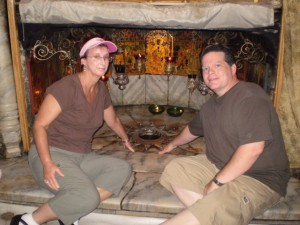It shouldn’t surprise that in the modern era, the traditional birthplace of Jesus, in Bethlehem, has become a tourist trap. Palestinian merchants smile at pilgrims and offer all sorts of trinkets.
The first time I visited the Church of the Nativity, I was shocked at its rather plain exterior. The doorway is small, but once inside, a fairly vast room opens up. This historically rich place has hosted the Messiah, the Crusaders, Palestinian terrorists, and pilgrims—both great and small.
Descending a series of steps, visitors can access—in a tight turnaround space—the alleged spot where Jesus was born and where the wisemen offered their gifts. Frankly, the religious trappings make it sort of the definition of kitsch, but one cannot deny the historical significance of the site.
If you ever visit the area (I would recommend it without reservation), don’t expect to see a small, ancient “inn.” Rather, the Lord was born in a grotto.
Although no one really believes He was born on December 25 (or even in winter), we can still have confidence that the Gospel accounts are accurate and that the Creator chose this humble place to enter the world as Savior, 2,000 years ago.
Whether you ever visit Bethlehem, or whether you look at photographs, the real significance is what you believe about its most famous visitor, from the lineage of the House of David.


